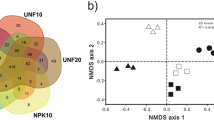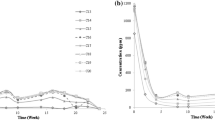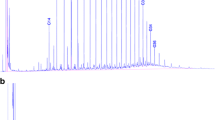Abstract
The effect of nutrient and inocula amendment in a bioremediation field trial using a nutrient-poor Antarctic soil chronically contaminated with hydrocarbons was tested. The analysis of the effects that the treatments caused in bacterial numbers and hydrocarbon removal was combined with the elucidation of the changes occurring on the bacterial community, by 16S rDNA-based terminal restriction fragment length polymorphism (T-RFLP) typing, and the detection of some of the genes involved in the catabolism of hydrocarbons. All treatments caused a significant increase in the number of bacteria able to grow on hydrocarbons and a significant decrease in the soil hydrocarbon content, as compared to the control. However, there were no significant differences between treatments. Comparison of the soil T-RFLP profiles indicated that there were changes in the structure and composition of bacterial communities during the bioremediation trial, although the communities in treated plots were highly similar irrespective of the treatment applied, and they had a similar temporal dynamics. These results showed that nutrient addition was the main factor contributing to the outcome of the bioremediation experiment. This was supported by the lack of evidence of the establishment of inoculated consortia in soils, since their characteristic electrophoretic peaks were only detectable in soil profiles at the beginning of the experiment. Genetic potential for naphthalene degradation, evidenced by detection of nahAc gene, was observed in all soil plots including the control. In treated plots, an increase in the detection of catechol degradation genes (nahH and catA) and in a key gene of denitrification (nosZ) was observed as well. These results indicate that treatments favored the degradation of aromatic hydrocarbons and probably stimulated denitrification, at least transiently. This mesocosm study shows that recovery of chronically contaminated Antarctic soils can be successfully accelerated using biostimulation with nutrients, and that this causes a change in the indigenous bacterial communities and in the genetic potential for hydrocarbon degradation.




Similar content being viewed by others
References
Aislabie JM, Saul DJ, Foght JM (2006) Bioremediation of hydrocarbon-contaminated polar soils. Extremophiles 10:171–179
Aislabie J, Fraser R, Duncan S, Farrell RL (2001) Effect of oil spills on microbial heterotrophs in Antarctic soils. Polar Biol 24:308–313
Aislabie JM, Balks MR, Foght JM, Waterhouse EJ (2004) Hydrocarbon spills on Antarctic soils: effects and management. Environ Sci Technol 38:1265–1274
Antarctic Treaty Consultative Parties (1991) Protocol on environmental protection to the Antarctic treaty. CM 1960. Her Majesty’s Stationery Office, London
Bouchez T, Patureau D, Dabert P, Juretschko S, Doré J, Delgenès P, Moletta R, Wagner M (2000) Ecological study of a bioaugmentation failure. Environ Microbiol 2:179–190
Bouchez T, Patureau D, Dabert P, Wagner M, Delgenès JP, Moletta R (2000) Successful and unsuccessful bioaugmentation experiments monitored by fluorescent in situ hybridization. Water Sci Technol 41:61–68
Cavanagh JE, Nichols PD, Franzmann PD, McMeekin TA (1998) Hydrocarbon degradation by Antarctic coastal bacteria. Antarct Sci 10:386–397
Cladera AM, Bennasar A, Barceló M, Lalucat J, García-Valdés E (2004) Comparative genetic diversity of Pseudomonas stutzeri genomovars, clonal structure, and phylogeny of the species. J Bacteriol 186:5239–5248
Delille D (2000) Response of Antarctic soil bacterial assemblages to contamination by diesel fuel and crude oil. Microb Ecol 40:159–168
Delille D, Pelletier E (2002) Natural attenuation of diesel-oil contamination in a subantarctic soil (Crozet Island). Polar Biol 25:682–687
Delille D, Coulon F, Pelletier E (2004) Biostimulation of natural microbial assemblages in oil-amended vegetated and desert sub-Antarctic soils. Microb Ecol 47:407–415
Dua M, Singh A, Sthunathan N, Johri AK (2002) Biotechnology and bioremediation: successes and limitations. Appl Microbiol Biotechnol 59:143–152
Espeche ME, Mac Cormack WP, Fraile ER (1994) Factors affecting growth of an n-hexadecane degrader Acinetobacter sp. isolated from a highly polluted urban river. Int Biodeter Biodegr 33:187–196
Fahy A, Lethbridge G, Earle R, Ball AS, Timmis KN, McGenity TJ (2005) Effects of long-term benzene pollution on bacterial diversity and community structure in groundwater. Environ Microbiol 7:1192–1199
Ferrero M, Llobet-Brossa E, Lalucat J, García-Valdés E, Rosselló-Mora R, Bosch R (2002) Coexistence of two distinct copies of naphthalene degradation genes in Pseudomonas strains isolated from the western Mediterranean region. Appl Environ Microbiol 68:957–962
García-Valdés E, Castillo MM, Bennasar A, Guasp C, Cladera AM, Bosch R, Engesser KH, Lalucat J (2003) Polyphasic characterization of Pseudomonas stutzeri CLN100, which simultaneously degrades chloro- and methylaromatics: a new genomovar within the species. Syst Appl Microbiol 26:390–403
Hammer Ø, Harper DAT, Ryan PD (2001) PAST: palaeontological statistics software package for education and data analysis. Palaeo Electronica 4:9
Kerry E (1993) Bioremediation of experimental petroleum spills on mineral soils in the Vestfold Hills, Antarctica. Polar Biol 13:163–170
Lane DJ (1991) 16S/23S rRNA sequencing. In: Stackebrandt E, Goodfellow M (eds) Nucleic acid techniques in bacterial systematics. Wiley, Chichester, pp 115–175
Lalucat J, Bennasar A, Bosch R, García-Valdés E, Palleroni NJ (2006) Biology of Pseudomonas stutzeri. Microbiol Mol Biol Rev 70:510–547
Luz AP, Pellizari VH, Whyte LG, Greer CW (2004) A survey of indigenous microbial hydrocarbon degradation genes in soils from Antarctica and Brazil. Can J Microbiol 50:323–333
Mac Cormack WP, Fraile ER (1997) Characterization of a hydrocarbon degrading psychrotrophic Antarctic bacterium. Antarct Sci 9:150–155
Margesin R, Hämmerle M, Tscherko D (2007) Microbial activity and community composition during bioremediation of diesel-oil contaminated soil: effects of hydrocarbon concentration, fertilizers, and incubation time. Microb Ecol 53:259–269
Mestre MC, Vazquez SC, Ruberto LAM, Mac Cormack WP (2007) Identificación de los componentes cultivables del consorcio bacteriano degradador de hidrocarburos M10. Proceedings of VI Jornadas Nacionales y III Latinoamericanas de Comunicaciones sobre Investigaciones Antárticas (Epub: http://www.dna.gov.ar/CIENCIA/SANTAR07/CD/PDF/CVRE407.PDF)
Mishra S, Jyot J, Kuhad RC, Lal B (2001) Evaluation of inoculum addition to stimulate in situ bioremediation of oily-sludge-contaminated soil. Appl Environ Microbiol 67:1675–1681
Mohn WW, Radziminski CZ, Fortin MC, Reimer KJ (2001) On site bioremediation of hydrocarbon-contaminated Arctic tundra soils in inoculated biopiles. Appl Microbiol Biotechnol 57:242–247
Nocker A, Burr M, Camper AK (2007) Genotypic microbial community profiling: a critical technical review. Microb Ecol 54:276–289
Nogales B, Moore E, Abraham W, Timmis K (1999) Identification of the metabolically active members of a bacterial community in a polychlorinated biphenyl-polluted moorland soil. Environ Microbiol 1:199–212
Osborn AM, Moore ERB, Timmis KN (2000) An evaluation of terminal-restriction fragment length polymorphism (T-RFLP) analysis for the study of microbial community structure and dynamics. Environ Microbiol 2:39–50
Powell SM, Ferguson SH, Snape I, Siciliano SD (2006) Fertilization stimulates anaerobic fuel degradation of Antarctic soils by denitrifying microorganisms. Environ Sci Technol 40:2011–2017
Powell SM, Ma WK, Siciliano SD (2006) Isolation of denitrifying bacteria from hydrocarbon-contaminated Antarctic soil. Polar Biol 30:69–74
Rakhimova ER, Osipova AL, Zaripova SK (2004) Purification of soil from oil pollutants with the use of denitrifying hydrocarbon-oxidizing microorganisms. Appl Biochem Microbiol 40:563–567
Röling WFM, Milner MG, Jones DM, Lee K, Daniel F, Swannell RJP, Head IM (2002) Robust hydrocarbon degradation and dynamics of bacterial communities during nutrient- enhanced oil spill bioremediation. Appl Environ Microbiol 68:5537–5548
Röling WFM, Milner MG, Jones DM, Fratepietro F, Swannell R, Daniel F, Swannell RJP, Head IM (2004) Bacterial community dynamics and hydrocarbon degradation during a field-scale evaluation of bioremediation on a mudflat beach contaminated with buried oil. Appl Environ Microbiol 70:2603–2613
Rosselló R, García-Valdés E, Lalucat J, Ursing J (1991) Genotypic and phenotypic diversity of Pseudomonas stutzeri. Syst Appl Microbiol 14:150–157
Ruberto LAM, Vázquez SC, Mac Cormack WP (2003) Effectiveness of the natural bacterial flora, biostimulation and bioaugmentation on the bioremediation of hydrocarbon contaminated Antarctic soil. Int Biodeter Biodegr 52:115–125
Ruberto LAM, Vázquez SC, Lobalbo A, Mac Cormack WP (2004) Biorremediación de suelos contaminados con hidrocarburos utilizando bacterias Antárticas sicrotolerantes. Actas del V° Simposio Argentino y 1° Latinoamericano sobre Investigaciones Antárticas. On-line publication in http://www.dna.gov.ar/CIENCIA/SANTAR04/CD/PDF/206BH.PDF, 5 pp
Ruberto LAM, Vázquez SC, Lobalbo A, Mac Cormack WP (2005) Psychrotolerant hydrocarbon-degrading Rhodococcus strains isolated from polluted Antarctic soils. Ant Sci 17:47–56
Ruberto L, Vázquez S, Curtosi A, Mestre MC, Pelletier E, Mac Cormack W (2006) Phenanthrene biodegradation in soils using an Antarctic bacterial consortium. Biorem J 10:191–201
Ruberto LAM, Vázquez SC, Mac Cormack WP (2008) Bacteriology of extremely cold soils exposed to hydrocarbon pollution. In: Dion P, Chandra Shekhar N (eds) Microbiology of extreme soils, soil biology, vol. 13. Springer, Berlin, pp 247–274
Sambrook J, Russell DW (2001) Molecular cloning, a laboratory manual. Cold Spring Harbor Laboratory Press, Cold Spring Harbor
Saul DJ, Aislabie JM, Brown CE, Harris L, Foght JM (2005) Hydrocarbon contamination changes the bacterial diversity of soil from around Scott Base, Antarctica. FEMS Microbiol Ecol 53:141–155
Schwartz RD, McCoy CJ (1973) Pseudomonas oleovorans hydroxylation–epoxidation system: additional strain improvements. Appl Microbiol 26:217–218
Smith CJ, Danilowicz BS, Clear AK, Costello FJ, Wilson B, Meijer WG (2005) T-Align, a web-based tool for comparison of multiple terminal restriction fragment length polymorphism profiles. FEMS Microbiol Ecol 54:375–380
Smits TH, Röthlisberger M, Witholt B, van Beilen JB (1999) Molecular screening for alkane hydroxylase genes in gram-negative and gram-positive strains. Environ Microbiol 1:307–317
Stallwood B, Shears J, Williams PA, Hughes KA (2005) Low temperature bioremediation of oil-contaminated soil using biostimulation and bioaugmentation with Pseudomonas sp. from maritime Antarctica. J Appl Microbiol 99:794–802
Tarnocai C, Campbell IB (2002) Soils of the polar regions. In: Lal R (ed) Encyclopaedia of soil science. Marcel Dekker, New York, pp 1018–1021
Thomassin-Lacroix EJM, Eriksson M, Reimer KJ, Mohn WW (2002) Biostimulation and bioaugmentation for on-site treatment of weathered diesel fuel in Arctic soil. Appl Microbiol Biotechnol 59:551–556
Tom-Petersen A, Leser TD, Marsh TL, Nybroe O (2003) Effects of copper amendment on the bacterial community in agricultural soil analyzed by the T-RFLP technique. FEMS Microbiol Ecol 46:53–62
USEPA (1983). Petroleum hydrocarbons, total recoverable. In: Methods for chemical analysis of water and waste. EPA-600-4-79-020, Cincinnati, Ohio, 418·1·1–418·1·3
Walter MV (1997) Bioaugmentation. In: Hurst CJ, Knudsen GR, McInerney MJ, Stetzenbach LD, Walter MV (eds) Manual of environmental microbiology. ASM, Washington DC, pp 753–757
Whyte LG, Bourbonniere L, Bellerose C, Greer CW (1999) Bioremediation assessment of hydrocarbon-contaminated soils from the high Arctic. Biorem J 3:69–79
Wynn-Williams DD (1992) Counting bacterial colony-forming units in soil. In: Wynn-Williams DD (ed) BIOTAS manual of methods for Antarctic terrestrial and freshwater research. Scientific Committee on Antarctic Research, Cambridge, p 3
Acknowledgements
This research was supported by grants from the Argentinean Antarctic Institute (IAA no. 42), the National Agency for Scientific and Technical Researches (PICTO 11555), and the University of Buenos Aires (UBACyT U007) as well as by a short-term travel fellowship from the Argentinean Research Council (CONICET). Research at the University of the Balearic Islands (UIB) was supported by grants VEM2003-20565 and CTM2005-01783 from the Spanish Ministry of Education and Science (MEC). B.N. was supported by a contract from the program “Ramón y Cajal” from MEC, and J.C-O by a fellowship of the Balearics Autonomous Government. The experience and assistance of logistic and technical personnel at Tte. Jubany Antarctic Station is also highly appreciated, as well as the support of the Scientific-Technical Services of the UIB during the operation of the genetic analyzer for fragment analysis.
Author information
Authors and Affiliations
Corresponding author
Electronic Supplementary Material
Below is the link of electronic supplementary material.
ESM Fig. 1
Weather conditions at Jubany Station, King George Island (Isla 25 de Mayo), South Shetland Islands, Antarctica, during the field experiment. Arrows indicate the sampling times (GIF 28 kb)
ESM Fig. 2
Relative moisture content (%) of soil during the field experiment. Black bars: community control plot (CC); white bars: biostimulated plots (AB); light gray bars: biostimulated and bioaugmented plots with M10 consortia (M10); and dark gray bars: biostimulated and bioaugmented plots with J13 consortia (J13). In the treated plots, the first bar corresponds to plot 1, the second one to plot 2, and the third one to plot 3 (GIF 20 kb)
Rights and permissions
About this article
Cite this article
Vázquez, S., Nogales, B., Ruberto, L. et al. Bacterial Community Dynamics during Bioremediation of Diesel Oil-Contaminated Antarctic Soil. Microb Ecol 57, 598–610 (2009). https://doi.org/10.1007/s00248-008-9420-9
Received:
Accepted:
Published:
Issue Date:
DOI: https://doi.org/10.1007/s00248-008-9420-9




